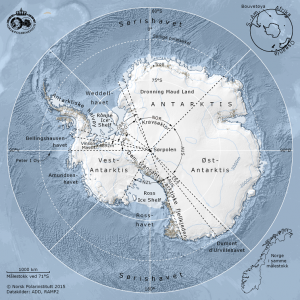Sovereignty issues and preconditions
At the end of World War II, seven states asserted sovereignty claims in relation to Antarctica: Argentina, Australia, Chile, France, New Zealand, Norway and the UK.
The idea of an international solution to the question of sovereignty in Antarctica was proposed several times after the war, but garnered little support. Nor did proposals to establish a jointly administered area or to place the area under UN management gain traction. However, the evident potential for conflict inherent in the different (occasionally conflicting) sovereignty claims necessitated clarification of the issue.

Map. The Norwegian Polar Institute
Science and cooperation
After World War II, there was greater focus on scientific activities and the Scientific Committee on Antarctic Research (SCAR) was founded. The success of international research cooperation in Antarctica led to the creation of the Antarctic Treaty in 1959.
While the Treaty was being negotiated, environmental protection was not on the agenda of the 12 signatory powers who prepared it. The environment gradually became an increasingly important topic for international cooperation.
Norway in the Antarctic Treaty
As the Norwegian executive authority in Antarctica, the Norwegian Polar Institute administrates the Norwegian dependent territories in Antarctica and the surrounding sea areas in accordance with applicable regulations and relevant international agreements.
Key provisions of the Treaty
The Treaty came into force on 23 June 1961 and defines a legal framework for activities in the area south of 60°S. The Treaty’s key provisions are as follows (the Roman numerals refer to the corresponding articles in the text of the Treaty):
- Antarctica may only be used for peaceful purposes. All military activities are prohibited, although the use of military personnel or equipment for scientific research or other peaceful activities is permitted (I)
- The freedom to conduct scientific research in Antarctica is a fundamental principle of the Treaty (II)
- International scientific cooperation shall be promoted through exchanges of research plans, personnel and scientific observations and results (III)
- As long as the Treaty applies, all territorial claims are set aside, and no new claims or enlarged claims may be made. Neither the Treaty itself nor activities taking place while it is in force shall constitute a basis for asserting new claims, or supporting or weakening existing claims, or provide grounds for claims of sovereignty (IV)
- Nuclear explosions or the storage of radioactive waste are prohibited in Antarctica (V)
- All stations and equipment may be inspected by observers designated by one or more of the Treaty signatories (VII)
Pursuant to article XII, the Antarctic Treaty allows for a conference to be held to evaluate the Treaty. Such a conference may be held on request of one or more signatory states once the Treaty has been in operation for 30 years (i.e. after 23 June 1991). Any state which so wishes (in other words, not only the signatory states) may participate in this conference. To date, no states have expressed a desire to organise such a conference, nor has any state indicated a desire to withdraw from the Treaty.
Parties to the Treaty
Any nation which is a member of the United Nations (UN) may accede to the Antarctic Treaty. The Treaty differentiates between consultative and non-consultative parties. Non-consultative parties can acquire the status of consultative parties if, after having signed the Treaty, they demonstrate their interest in Antarctica by conducting substantial scientific research activity there.
This differentiation was introduced to ensure that decisions with far-reaching implications for the future of the continent are taken by nations that have an interest in and direct knowledge of Antarctica. In practice, this difference has had little effect since all decisions are unanimous. This ensures that each well-founded proposal is carefully evaluated.
As at 2016, the Treaty had 29 consultative parties and 24 non-consultative parties.
